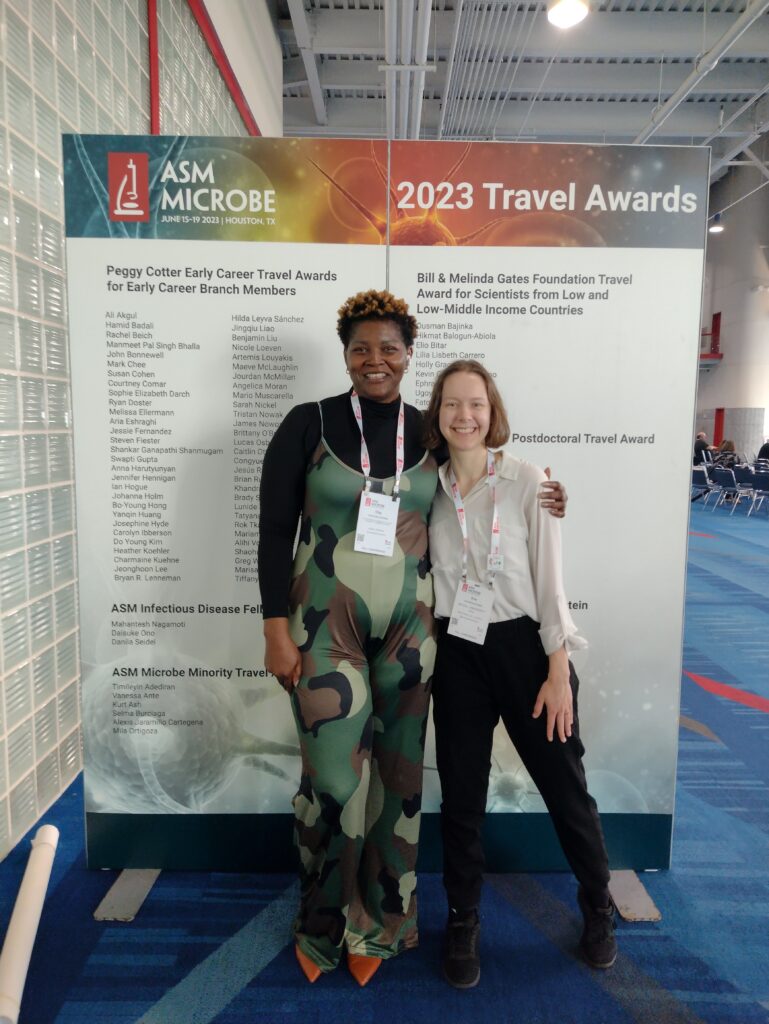By Eve Beauchemin, a PhD student at Concordia University
With the generous support of the QCBS in the form of the QCBS Excellence Award, I was able to attend the American Society of Microbiology (ASM) Microbe conference from June 15-19th, 2023 in the hot and humid city of Houston, Texas, USA. This international conference is one of the largest gatherings of microbiologists in the world – it is large in scope, in the number of participants and vendors present, and in the great diversity of attendants. One of the main goals of this conference is to bring together researchers from across the United States and around the globe, whether or not their research is based in the USA, to share their latest research and connect with each other.

Since Houston is known as “Space City” – being the headquarters of the National Aeronautics and Space Administration (NASA) – there were many sessions and talks focused on spaceflight, astronaut health, and many of the other complications in building management and lifestyle that arise when in space. One of my favourite talks was by Professor Cheryl Nickerson, who discussed her work on an in vitro system to simulate the conditions of spaceflight – namely, the low fluid shear force which results from a low gravity environment. The most intriguing finding of hers was that a typical intestinal pathogen, Salmonella enterica Serovar Typhimurium, changes its gene expression when infecting host tissue under low fluid sheer force versus in a normal (Earth) gravity environment. The host tissue changes its gene expression too, by increasing the expression of genes involved in inflammation and tissue repair. The result is unfortunately an increased virulence of the pathogen in this system. Interestingly, there are parts of our body which also have low fluid shear force, such as our bloodstream and our intestinal tract. This means the findings of Prof. Nickerson’s study could apply to situations beyond astronaut health in space.
Although international conferences are an amazing opportunity to attend fantastic talks, trying to make connections in such big events can be challenging. Luckily for me, while I was preparing for my trip to ASM, I happened to stumble across the Binning Singletons initiative (check them out here!). Essentially, Binning Singletons aims to help those who are attending ASM for the first time, and/or those who are attending alone, to have a more enjoyable time. The group pairs you with others who are attending alone and with whom you have similar research and career interests, and matches you all to a Mentor who knows ASM well and can guide everyone. The goal is to provide you with familiar faces and a guide to help you make the most of your time while navigating this huge, intimidating conference. They not only had a Slack group with active participation — which helped me prepare for the conference as well as providing helpful tips on the conference venue and host city — but they also provided information on ASM-related social and learning events (like the Microbe Bazaar, which was an informal rotation-based booth setup of various microbial topics, from food and alcohol fermentation to the gut-brain-bacteria connection to space-friendly food manufacturing), and Binning Singletons-exclusive events, such as the Binning Singletons dinner (which was a very fancy multi-course dinner and a great way to meet other Singletons and their mentors, and/or to meet up with your own mentor), and other more informal meetups (exclusive to Binning Singletons and otherwise) throughout the conference.
As far as my Bin went, we had a lovely dinner together in a Louisiana-inspired seafood restaurant called Pappadeaux, which was conveniently located within the immense conference center. It was a delicious treat (the first time I’ve ever eaten crawfish!) and a wonderful way to interact with my peers and with people who have the kind of career(s) I’m interested in. It was so nice to hang out, get to know people who were also interested in getting to know me, and have familiar faces that I could always turn to at any time during the event. For instance, I met some really fantastic women (also graduate students like me) during the Binning Singletons dinner, and we informally presented our posters to each other. They were very friendly and kind. The simple act of just being able to hang out with them during the conference really transformed the whole experience for the better.
Another way I kept social during the conference was by choosing to stay in a hostel during the conference. Because of this, I met a lot of very kind and friendly people from all walks of life. Everyone at the hostel was very welcoming and inviting, despite the fact that we were all complete strangers to each other. There were also many people at the hostel who were attending the ASM conference too! We chatted casually with each other in the kitchen, while making breakfast before going to the conference or while finishing up dinner after a long conference day.
One woman who was staying in the same hostel dorm room as me, Constance, took me under her wing. She helped me navigate this vast conference and taught me how to collect as many free goodies from the vendors as possible (as well as how to pack everything up to fit in the same bags I brought with me). It was wonderful to commute with her to the conference each morning. I could count on her as my buddy, and we had a lot of fun together. It was eye-opening and humbling to learn a little about her life story. She is from Nigeria, and only recently moved to the United States in the hopes of establishing a more promising career for her and her students. Her interests were mainly in education – training the next generation of microbiologists. She was specifically focused on trying to get Nigerian children interested in the sciences as a career, instead of the typical high-paying but extremely competitive fields that children typically seek to pursue (such as medical doctor or a lawyer). Her very real personal struggles being alone and far from everything she has ever known, and her unrelenting perseverance and faith in herself and what was important to her, were both very moving and motivating. She was also a very sweet and extremely sociable woman, who could talk and connect with anyone she happened to be sitting or standing next to. On the last day of the conference, we shared a Nigerian meal together. I had never had that kind of cuisine before. I love trying new things and I was not disappointed with the quality and quantity of the food – some jollof rice with fried plantains, and a deliciously saucy and spicy tilapia, bones and all.

Outside of networking (and having a good time meeting great people) one of the other essential aspects of attending a conference is, of course, presenting your work. Depending on where you’re at in your graduate career, this type of presentation can serve to help you get feedback on your work, find collaborators to improve or broaden your research, advertise your latest publication or publication-worthy work, or network for future career/position opportunities. As I am (finally) wrapping up my PhD, I certainly fell into the latter two categories.
While I was standing next to my poster during the designated presentation time, the poster presenter next to me happened to be an editor at mSystems, an ASM-owned journal. They saw my work and thought it would be a good fit for the journal and gave me their business card to contact them whenever the manuscript was ready for submission. This was a really unexpected and helpful interaction for me, since I’m currently working on my second (and last) manuscript before I concentrate fully on writing my thesis. This interaction was exactly the kind of thing that I needed, and I was lucky that I didn’t have to go out of my way to find it – the opportunity came to me when I least expected it.
Similarly, when I was presenting my research to some other attendees who came up to me, I received two separate opportunities for a postdoctoral fellowship. Again, luck and timing were on my side. I also believe that it helped that I was genuine and honest — I shared my work and all its limitations with no hesitation, and they took me for who I was and somehow still thought that I showed promise as a postdoctoral researcher. This is something I mentioned in my previous blog post about ISME (go check it out if you’re interested!). Before attending ASM Microbe, I was having a lot of anxiety and doubt as far as my “hireability”, considering what I had heard from my supervisor about how competitive it is to land a postdoctoral position. And perhaps it truly is that competitive – I’m sure I wasn’t the only one these PIs approached at the conference. But the fact that anyone reached out to me at all and believed in me and my skills really boosted my confidence in myself and my ability to one day land a “real job”.

When I wasn’t presenting my poster or attending talks, there were many vendors to visit. They were all positioned in the same location where the posters boards were set up. Out of the many (>100) vendor booths at ASM, from which I obtained many goodies (pens, candies, and trinkets galore) there were a few dedicated to various governmental departments conducting scientific research. These governmental agencies were particularly interesting to me as far as career opportunities. I made sure to talk to people who were currently working in various departments of the United States government, and I learned about the job prospects and fellowships available for someone with an educational background like mine. This was exactly the kind of information I needed for my future steps, and it was a lot more helpful to hear about it from living, breathing people than getting lost navigating the maze of sometimes poorly designed government websites.
In the end, I would like to thank the QCBS again for their support of my work and my attendance at ASM Microbe. I cannot express enough how grateful and privileged I was to attend this conference and get everything I was looking for, which will help pave the way for the next steps of my career once I graduate. I gained friends that I look forward to seeing again, made career connections with those in positions I am interested in, secured a publishing opportunity for my manuscript-in-process, and received several career opportunities as both a postdoctoral fellow and a US government employee (or fellow).
I would encourage other QCBS members to apply for this award if ever they see an opportunity for a conference, workshop, or international collaboration that would positively impact their research and their career, and not let finances limit their dreams, since they have access to funds like this one. I can promise that it’s worth it to submit your application – you never know, you might get exactly what you’re looking/hoping for!

About the author: Eve Beauchemin is a PhD Candidate in the lab of Corinne Maurice, PhD, at McGill University in Montreal, Québec, Canada. She first became interested in the gut microbiome and its importance to host health in an introductory microbiology class during her undergraduate career and has stuck with it ever since! She now has a particular interest in viewing the gut microbiome through the lens of microbial ecology and host-microbe interactions.
You can find the website of the Maurice lab here: http://www.mauricelab.ca/
Eve’s Twitter: https://twitter.com/eve_beauchemin @eve_beaucheminEve’s LinkedIn: https://www.linkedin.com/in/eve-beauchemin/

0 Comments